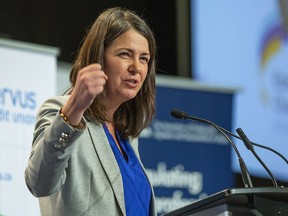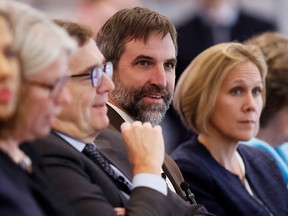Both sides should sit down and hash out a new regime that activates billions of dollars in proposed CCUS projects
Author of the article:Chris Varcoe • Calgary Herald
Publishing date:Oct 20, 2022

Mr. Prime Minister, Alberta has a new premier and she doesn’t like your climate policies, “so what specifically are you doing to work with her government to address the emissions problem?”
This was the question from a Bloomberg News journalist to Justin Trudeau at a climate conference in Ottawa this week.
His response was a classic example of partisan deflection.
“It’s interesting because you see a position in which Conservative politicians in Canada are actually distancing themselves from the positions of the industries they’re supposed to protect. The oil and gas industry in Canada has made very strong declarations about needing to get to net-zero by 2050,” Trudeau told a Canadian Climate Institute conference.
“Listen, Alberta politicians will continue to say what they say. What Albertans are actually saying, what industry leaders are actually saying, is how do we manage this together?
“How do we get the pace right so we can decarbonize quickly, while still being there to provide the very real short-term energy needs.”
But don’t worry about Premier Danielle Smith. She’s been getting a few practice swings in on the energy file in her first couple of weeks on the job.

In her victory speech after becoming UCP leader, Smith vowed Alberta “will not have our resources landlocked or our energy phased out of existence by virtue-signalling prime ministers.”
At a news conference, Smith blasted Environment Minister Steven Guilbeault, saying “he’s done nothing but attack our industry,” and said Alberta will send its own delegation to the COP27 climate meeting next month.
“I’m not sure why we haven’t attended those in the past, but . . . with such a hostile environment minister in Steven Guilbeault, they would keep getting hit after hit after hit,” Smith told an Edmonton Chamber of Commerce event on Thursday.
“We cannot have our message on the world stage with Steven Guilbeault being our emissary on that.”
If the two sides want to do something constructive, here’s a novel idea: quickly find some common ground.
Both sides should sit down and hash out a new regime that activates billions of dollars in proposed investments in carbon capture, utilization and storage (CCUS) projects in short order.
Part of it should look for ways to speed up the regulatory process; they should also look at the financial side of the equation.
After taking an entire year to put together an investment tax credit for CCUS projects, the Trudeau government this spring finally offered up a 50-per-cent credit for spending on equipment that’s required to capture CO2
It also called on the provinces to step up.
RECOMMENDED FROM EDITORIAL

Varcoe: Canada 'falling behind' in race to attract carbon capture investments

U.S. incentives for carbon capture could lure investment south
Mark Carney says Canada should make a 'big bet' on carbon capture
Alberta pointed to royalty offsets available within its existing oilsands royalty structure that provide incentives for major capital costs tied to such projects.
Meanwhile, the U.S. has waltzed past Canada, adopting an even bolder program than what Ottawa announced by passing its new Inflation Reduction Act this summer. It boosts the existing U.S. government tax credit for such projects to $85 for each tonne of stored CO2, a jump from $50.
On Wednesday, the Business Council of Canada sent a letter to Finance Minister Chrystia Freeland, noting she recently indicated the federal government would fast-track energy projects to assist Canada’s allies.
“For major projects to go ahead, however, investors need regulatory predictability,” states the letter from council CEO Goldy Hyder.
“Such a declaration should spell out in detail the kinds of projects the government is prepared to fast-track and . . . outline any incentives — financial or otherwise — which the government will put in place in response to those contained in the United States’ Inflation Reduction Act.”

The future of decarbonizing Alberta’s energy industry through CCUS is waiting for such clarity.
The Pathways Alliance, compromising large oilsands producers such as Cenovus Energy and Suncor Energy, estimates the cost of its foundational carbon capture and storage hub at $16.5 billion by 2030 as it strives to reach net-zero emissions by 2050.
Suncor Energy’s chief climate officer Martha Hall Findlay, who announced this week she will retire at the end of November, said the alliance welcomes the federal credit and this month’s decision by Alberta to allocate the group pore space necessary for its planned CCUS hub.
However, it has done analysis on the gap between Canada’s incentives and the U.S. plan — and Ottawa knows it must do more to be competitive, said Hall Findlay, a former Liberal MP and past CEO of the Canada West Foundation.
“Even with our carbon pricing in Canada, the difference now between the environment in the United States and in Canada is still very big,” she said in an interview.
A number of other proposed decarbonization projects in Alberta are also in the wings, including Enbridge’s Wabamun Carbon Hub initiative with Capital Power and Lehigh Cement, and the Alberta Carbon Grid development, led by Pembina Pipeline and TC Energy.
“It is a pretty pivotal point in the dialogue,” said Michael Gullo, the business council’s vice-president of policy.
“This is go time.”
On the provincial front, little progress was made while the leadership race to replace Jason Kenney unfolded.
The ball now rests squarely in the court of Smith and her new cabinet, which will be announced Friday.
Federally, there have been signals Ottawa may respond to the new measures south of the border.
On Wednesday, Freeland also suggested the fall economic update could offer more clarity to closing the gap with the U.S.
For Hall Findlay, collaboration is the way to get things moving, noting the group will need to see investment from both the provincial government and Ottawa.
“The world is going to need what we produce for the next number of decades. So our view is what we are doing is, in fact, incredibly important to the prosperity of Alberta,” she added.
“All I can do right now is encourage Alberta and the federal government to come and join us at the table all together and really figure out how we can do this — not only for Alberta, but for Canada.”
Chris Varcoe is a Calgary Herald columnist.
Oilsands group pledges to spend $16.5B on carbon capture project by 2030
, The Canadian Press
Canada's biggest oilsands companies say they will spend $16.5 billion before 2030 on a massive proposed carbon capture and storage facility that is the centrepiece of their net-zero-by-2050 pledge.
The Pathways Alliance, a consortium of the country's six largest oilsands companies, said Friday it will also spend an additional $7.6 billion on other emissions reductions projects, for a total of around $24.1 billion.
The announcement comes as Canada's oil and gas industry has been under fire from environmental groups who say not enough of the record profits being reaped this year due to sky-high oil prices are being funneled into decarbonization.
Last month, a report from environmental think-tank the Pembina Institute said Canada's oil and gas sector is estimated to earn a profit of $152 billion in 2022 due to the war in Ukraine and the resulting commodity price boom. The report criticized the industry for not moving faster to meet its climate commitments in light of its windfall profits.
Federal Environment Minister Steven Guilbeault has also said he wants to see more details from industry on what it is doing with its profits to achieve its emissions-reduction targets.
"If they don't make those investments while they're making record-level profits, then when would it be a good time for them to make those investments?" Guilbeault said in a September interview. "If not now, then I don't know when.''
The Pathways Alliance has not yet made a final investment decision on the project, which would capture CO2 emissions from more than 20 oilsands facilities in northern Alberta and store them safely underground, delivering an estimated 10 million tonnes of emissions reductions per year.
But it says it has already completed pre-engineering work and is consulting with Indigenous communities along the route of the proposed 400-km pipeline that would carry captured CO2 to the storage hub. The group says it has also completed nine carbon capture feasibility studies involving member companies at oil sands sites.
Earlier this year, the federal government announced an investment tax credit for carbon capture and storage (CCS) that will enable companies to claim a tax credit of up to 60 per cent for direct air capture projects and 50 per cent for all other eligible carbon capture projects. A 37.5 per cent tax credit is available for investment in equipment for carbon transportation, storage and use.
But oilsands CEOs have said more government support will be necessary to make the building and operating of such expensive, cutting-edge technology economical.
“A CCS project of this size is a huge undertaking that requires significant up-front work and a strong partnership between industry and government to proceed,” said Kendall Dilling, president of Pathways Alliance, in a news release.
The industry has also said the government's overall targets for the oil and gas sector are unrealistic. While the Pathways Alliance has said it believes it can reduce greenhouse gas emissions from production by 22 million tonnes by 2030 — an approximate 30 per cent reduction from current levels — the federal government wants Canada's oilpatch to reduce by 42 per cent below 2019 levels.
That would bring total emissions from the sector to 110 million tonnes by 2030, down from 191 million tonnes in 2019. They haven't been that low in more than three decades.
“We continue to work with the federal and Alberta governments to ensure Canada’s co-funding programs and regulatory environment for CCS are globally competitive and that emissions reduction targets for our industry are realistic and achievable," Dilling said Friday.
“In parallel, we’re progressing work to make sure we’re ready to make an investment decision and start building as soon as the necessary financial and regulatory conditions are in place.”
The Pathways Alliance is made up of member companies Canadian Natural Resources Ltd., Cenovus Energy Inc., ConocoPhillips Canada, Imperial Oil Ltd., MEG Energy Corp., and Suncor Energy Inc.
The group says it plans to apply for regulatory approval for its CO2 transportation line and storage network in late 2023. It says it could begin injecting carbon as early as 2026
No comments:
Post a Comment